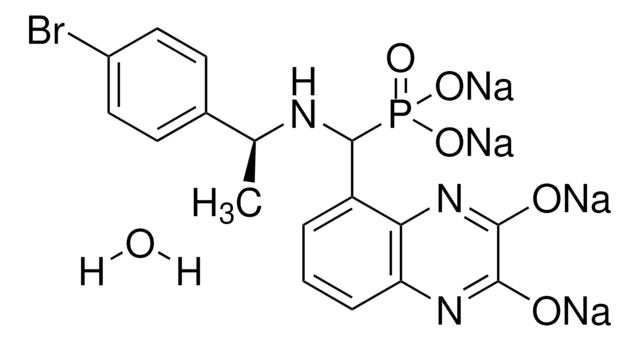N183
NBQX disodium salt hydrate
≥98% (HPLC), lyophilized powder, neuroprotective AMPA/kainate glutamate receptor antagonist
Synonym(s):
1,2,3,4-Tetrahydro-6-nitro-2,3-dioxo-benzo[f]quinoxaline-7-sulfonamide disodium salt hydrate, FG 9202 disodium salt hydrate
About This Item
Recommended Products
product name
NBQX disodium salt hydrate, ≥98% (HPLC)
Quality Level
Assay
≥98% (HPLC)
form
lyophilized powder
storage condition
desiccated
color
, brown to dark red-brown
solubility
H2O: >10 mg/mL
storage temp.
2-8°C
SMILES string
O.[Na+].[Na+].NS(=O)(=O)c1cccc2c1c(cc3nc([O-])c([O-])nc23)[N+]([O-])=O
InChI
1S/C12H8N4O6S.2Na.H2O/c13-23(21,22)8-3-1-2-5-9(8)7(16(19)20)4-6-10(5)15-12(18)11(17)14-6;;;/h1-4H,(H,14,17)(H,15,18)(H2,13,21,22);;;1H2/q;2*+1;/p-2
InChI key
LQSCHRKYVVVUFA-UHFFFAOYSA-L
Gene Information
human ... GRIA1(2890) , GRIA2(2891) , GRIA3(2892) , GRIA4(2893) , GRIK1(2897) , GRIK2(2898) , GRIK3(2899) , GRIK4(2900) , GRIK5(2901)
Application
- in N-methyl-D-aspartate receptor (NMDAR) kinetic studies
- as an α-amino-3-hydroxy-5-methyl-4-isoxazolepropionic acid (AMPA) receptor antagonist for the electrophysiological studies cultured neurons
- in the extracellular solution for current/voltage (I/V) relationship and rectification index experiments in excitatory postsynaptic currents (EPSCs) mediated by NMDA receptors (EPSCNMDAR)
Biochem/physiol Actions
Features and Benefits
Signal Word
Warning
Hazard Statements
Precautionary Statements
Hazard Classifications
Eye Irrit. 2 - Skin Irrit. 2 - STOT SE 3
Target Organs
Respiratory system
Storage Class Code
11 - Combustible Solids
WGK
WGK 3
Flash Point(F)
Not applicable
Flash Point(C)
Not applicable
Personal Protective Equipment
Certificates of Analysis (COA)
Search for Certificates of Analysis (COA) by entering the products Lot/Batch Number. Lot and Batch Numbers can be found on a product’s label following the words ‘Lot’ or ‘Batch’.
Already Own This Product?
Find documentation for the products that you have recently purchased in the Document Library.
Customers Also Viewed
Articles
DISCOVER Bioactive Small Molecules for Neuroscience
Our team of scientists has experience in all areas of research including Life Science, Material Science, Chemical Synthesis, Chromatography, Analytical and many others.
Contact Technical Service











